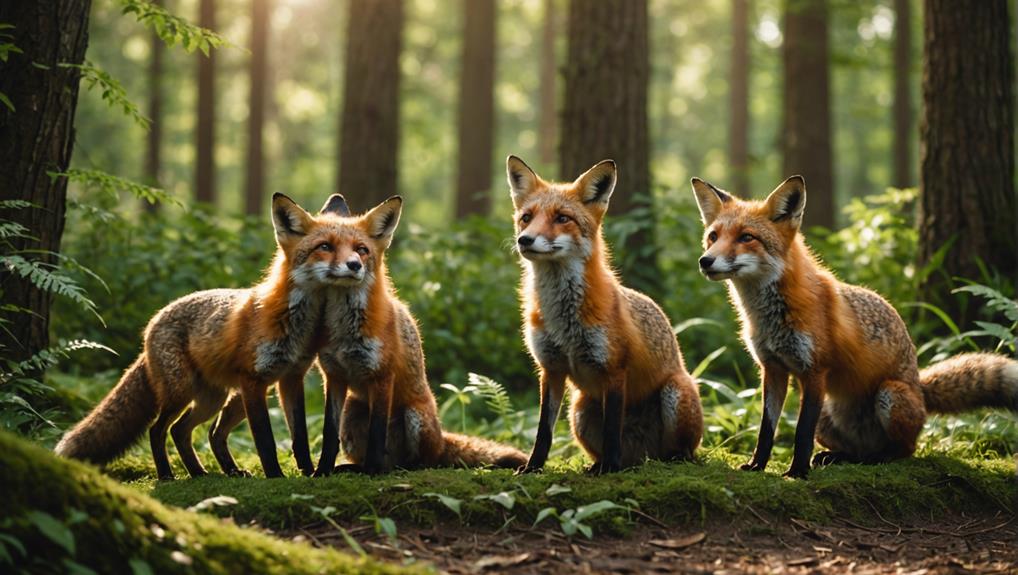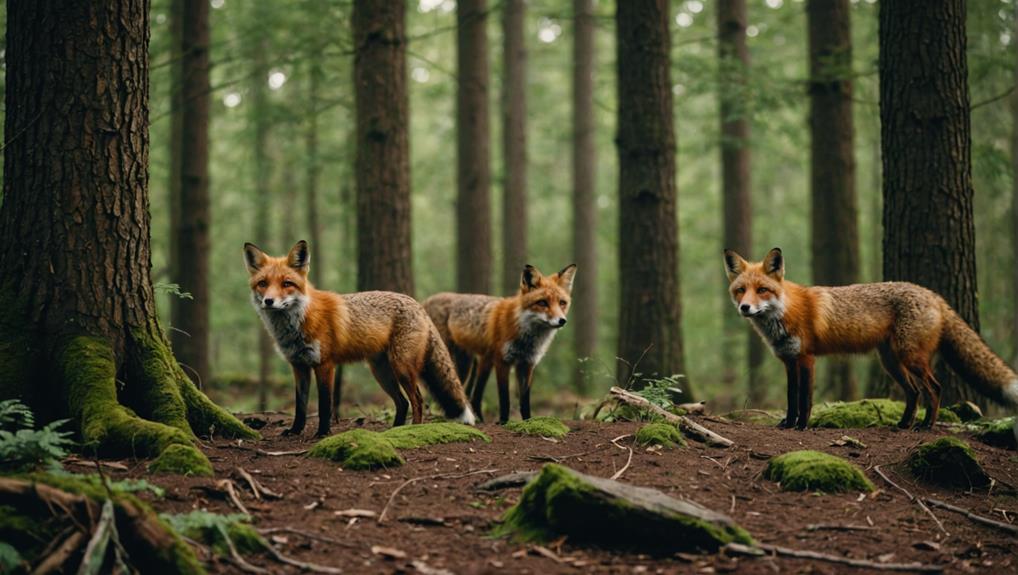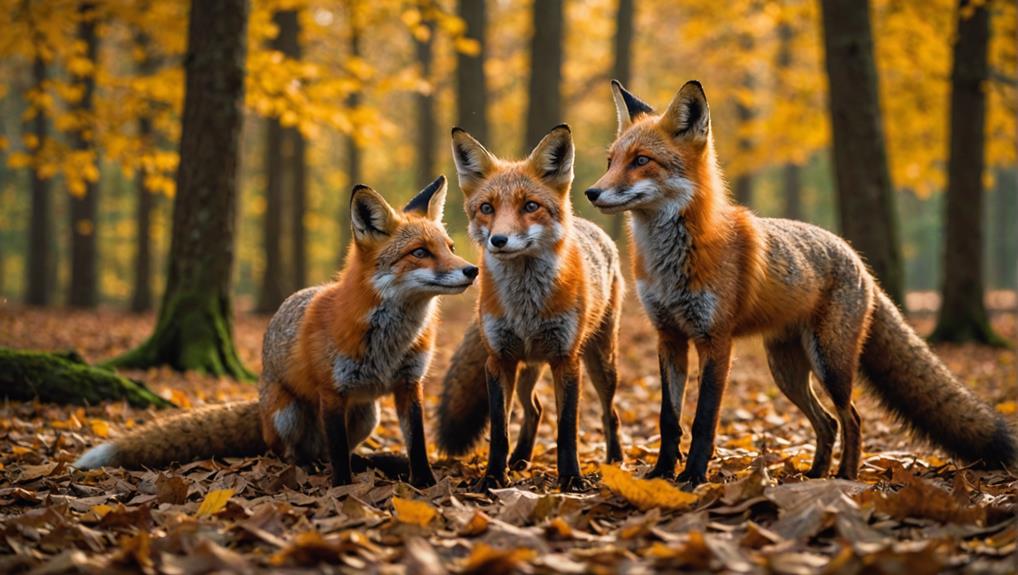Foxes communicate in their packs to strengthen their bonds, cooperate better, and navigate their world more effectively. They've got a whole toolbox of tricks, from over twenty different vocalizations to body language and scent marking. Whether it's a playful yip or a serious bark, each sound has meaning, helping them express everything from joy to warning signals. Their tails and ears also tell you a lot about what they're feeling or planning. By using all these forms of communication, foxes keep their pack connected and thrive together. Curious about how they achieve all this? There's even more to uncover!
Contents
Understanding Fox Communication
When you think of foxes, you might picture their cleverness and agility, but their ability to communicate is equally fascinating. Urban foxes, for instance, exhibit strong social structures that enhance their communication skills, making it essential for their survival in diverse environments.
Foxes use over twenty distinct vocalizations, like barks, yips, and whines, to convey everything from mating calls to alerts about danger. Imagine being part of a social group where each sound carries a specific message—how cool is that?
Scent marking is another critical communication method. When a fox leaves its mark, it's not just claiming territory; it's also saying, "Hey, I'm here!" This helps individual foxes identify one another within their community.
Plus, body language plays a huge role too! A fox's ear position or tail movement can express emotions and intentions, making their interactions lively and engaging.
Let's not forget the little ones—cubs! They learn essential communication skills through playful fighting and mimicking adult behaviors. This playful learning fosters strong social structures within their packs, ensuring they grow up to be just as clever and agile as their parents.
Vocal Signals and Their Meanings
Foxes have a remarkable vocal range, boasting over twenty distinct sounds that they use to communicate within their packs. Curiously, their vocalizations are part of their social behavior, which is essential for coordinating activities and maintaining bonds among family groups.
You might be surprised to learn that these vocalizations serve several important purposes, keeping their social groups connected and informed. Here are three key functions:
- Mating Calls: During the breeding season, high-pitched sounds, almost like a human wail, help vixens attract males. It's like their version of a romantic serenade!
- Territory Defense: Foxes use barks and yips to warn others about potential threats. This keeps their territory safe and guarantees everyone knows when to be on high alert.
- Emotional Expressions: From playful squeals during cub playtime to whines that signal distress, vocalizations help convey feelings and strengthen bonds within the pack.
Foxes often communicate in various contexts, adapting their sounds based on their environment, which is essential for their survival in diverse habitats, such as their adaptations in diverse habitats.
The diversity in sounds allows foxes to express everything from joy to fear, adapting their calls based on their environment.
Body Language and Social Cues

Body language plays a significant role in how foxes communicate within their packs, often conveying emotions and intentions more powerfully than vocalizations alone. You might notice that a wagging tail usually signals joy or playfulness, while a raised tail can mean they're alert or ready for mating. Isn't that fascinating?
Ear positioning is another important part of their body language. When you see a fox with backward ears, it might be feeling defensive or submissive. On the other hand, erect ears? That's a sign of curiosity or aggression!
Foxes also use submissive behavior, like crouching low, to navigate their dominance hierarchy within the pack. It's their way of showing respect and keeping the peace.
Young foxes often engage in playful fighting, mimicking adult behaviors, which helps them learn essential communication cues. This playful practice teaches them how to fit into their social groups effectively.
The Role of Scent Marking
Scent marking plays an essential role in how foxes communicate and establish their territory. By marking their space, they send a clear message: "This is my area!"
You might find it fascinating that scent marking does more than just claim territory. It also helps promote group cohesion and signals readiness during the breeding season. Urban foxes exhibit strong adaptability in their use of scent marking, which is important for their survival in densely populated areas.
Here's how it works:
- Establishing Territorial Boundaries: Foxes use their urine and feces to create a distinct line that tells others to back off. It's like hanging a "Keep Out" sign!
- Attracting Mates: During the breeding season, these scent marks can help attract potential partners. The stronger the scent, the more appealing the fox seems!
- Guiding Pack Members: Foxes leave scent trails that help their friends navigate through their territory. It's their version of a GPS, keeping everyone connected and aware.
In essence, scent marking is important for maintaining social structure and boundaries.
It's a delightful mix of communication and practical navigation, ensuring that each fox stays in tune with the group while also keeping their territory in check.
Social Hierarchy in Fox Packs

When you think about fox packs, it's fascinating how their social hierarchy shapes their lives. At the top, you've got the dominant vixen and dog fox, but below them, things can get a bit tense, especially among the males who often spar for dominance.
Meanwhile, the family ties among the cubs create a supportive network, showing that cooperation can really pay off when it comes to raising the next generation of clever little foxes!
Dominant Vixen Role
Dominant Vixen Role (Social Hierarchy in Fox Packs)
Playing a pivotal role in the social hierarchy of fox packs, the dominant vixen is vital for maintaining cohesion and organization within the group. She's not just any fox; she takes charge of group dynamics, ensuring that everyone plays their part.
Red foxes are known for their adaptability, which is reflected in their social structures as well. Here are three key responsibilities she embraces:
- Breeding and Cub Rearing: The dominant vixen is usually the only female that breeds, regulating the population and ensuring a strong genetic line. Her experience is invaluable in raising healthy cubs, which is important for the survival of the pack in various environments, including urban areas where they often thrive in diverse environments.
- Foraging and Hunting: Leading the pack in searching for food, she uses her knowledge to find resources, especially when times are tough. Think of her as the group's resource manager!
- Territory Defense: With her support, subordinate vixens help defend the pack's territory. This teamwork strengthens their bond and enhances the survival chances of the young.
Male Aggression Dynamics
The dynamics of male aggression in fox packs markedly influence their social structure, especially as males reach sexual maturity. As observed in species like the Red Fox, you'll notice that this aggression often spikes as younger males compete for breeding opportunities. Fights can break out, but they're not just about bravado; they help establish dominance hierarchies.
In these social groups, a mated pair typically leads, while subordinate males might adopt a lower body posture to keep the peace. These hierarchies are essential for maintaining stability within the pack. Dominant males gain the best access to territory and mates, ensuring their genetic legacy.
However, it's interesting to see that aggression isn't purely about rivalry. Subordinate males often stick around to assist with territorial defense and care for younger siblings. They play a significant role in the group's survival.
In crowded environments, competition can escalate, leading to higher aggression levels. Sometimes, this means a subordinate male might be pushed out to prevent inbreeding—nature's way of ensuring diversity.
Kin Cooperation Benefits
Kin cooperation in red fox packs is essential for their social structure, as related females, especially subordinate vixens, band together to bolster group stability and support cub rearing.
You see, in a family group, the dominant vixen leads, ensuring everyone has what they need. This teamwork creates a nurturing environment where everyone thrives.
Here are three key benefits of this kin cooperation:
- Enhanced cub care: Subordinate females step up, helping raise the young while the dominant pair focuses on maintaining the pack's stability.
- Food provision: These supportive vixens forage for food, ensuring that everyone, including cubs, gets enough to eat. It's like a potluck, but with less casserole!
- Genetic fitness: By working together, they increase the chances of their shared genes surviving, which is a win for the family.
When competition arises among male foxes, it's the clear social hierarchy that keeps things in check.
Vocalizations and displays help maintain peace, allowing these clever creatures to focus on what matters most: their family and the joy of working together.
Isn't that just wonderful?
Communication and Survival Strategies
Scent marking is another key part of their communication methods.
Foxes leave scent trails and fecal markings to establish territories and say, "Hey, this is mine!" It's like putting up a "No Trespassing" sign, but with a little more flair.
Their body language also plays a big role—just think about how a wagging tail or perked ears can tell you a lot about how a fox feels.
Final Thoughts
In the wild world of foxes, communication is key to their survival. Whether it's through barks, body language, or scent, these clever creatures know how to keep their pack connected. Just like a well-oiled machine, each signal plays an essential role in maintaining harmony and ensuring safety. So next time you hear a fox, remember, they're not just making noise—they're chatting up a storm! These furry friends truly show us that teamwork makes the dream work.














